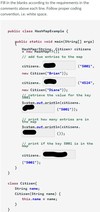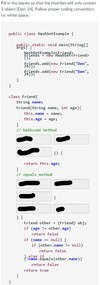Skillstorm Intro to Coding - Data Structures in Java Flashcards
(105 cards)
In Java, every Object has two comparison methods. What are they?
equals and hashCode Methods
The equals and hashCode methods must be _________ to work properly.
Why?
Overridden
Without them, you would have to create very large “if” comparisons, comparing every field from an object, making code really confusing and hard to read.
Fill in the Blanks of the attached image

boolean equals Object
Fill in the blanks of the following code:
public _____ _____ () {
final int prime = 31;
int result = 1;
result = prime * result + size;
if (topping == null) {
result = prime * result + 0;
}else {
result = prime * result + topping.hashCode();
}
return result;
}
int hashCode
A List is an _________ collection that may contain _________ elements.
Ordered
duplicate
What are the two types of general-purpose list implementations?
ArrayList and LinkedList
Are Java LinkedList automatically Doubly LinkedList?
Yes
ArrayLists are resizable. But by what size do they increase when they are full?
50%
ArrayList and LinkedList are both ordered by ________ position.
index
Because you can add and remove from the heads and tails of LinkedList, this makes them perfect for __________ and __________.
Stacks (and) Queues
What is Last In First Out? Stacks or Queues
Stacks
What is First In First Out? Stacks or Queues
Queues
Manipulating LinkedList. See image…

add
add
remove
Manipulating ArrayList. See attached image…

< String >
add
get
size
What is a Queue?
A collection for holding elements prior to processing
A ________ is a double-ended queue.
Deque
A Deque supports ________, removal, and __________ of elements at both end-points!
insertion,
examination
Deque interface implements both ______ and ______ at the same time.
Stacks
Queues
Queue Manipulation. See attached images…

queue. offer
queue. peek
queue. poll
Stack Manipulation. See attached images…

push
push
pop
peek
- Is a Map an object that maps equal keys?
- What are mapped to unique keys?
- Do Maps include methods for basic operations?
- Do Maps include methods for non-bulk operations?
- Do Maps includes methods for collection views?
- False: They map unique keys
- Values
- True
- False: They include methods for bulk operations
- True
Java contains three general-purpose Map implementations. What are they?
HashMap, TreeMap, and LinkedHashMap
HashMap Manipulation. See attached image…

put
put
get
size
containsKey
Can a Set contain duplicate elements?
No



